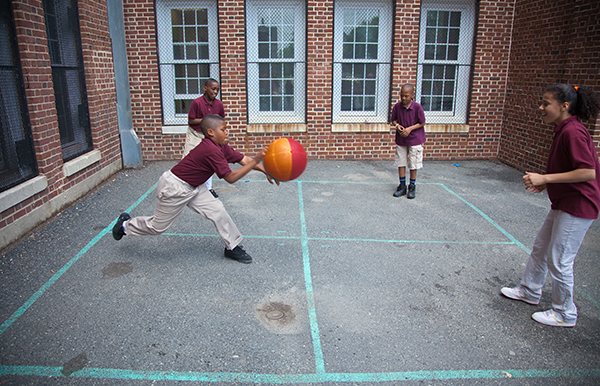The History of Four Square
Are you looking for a pastime that challenges your speed, motor skills and coordination? With summer here, do you want something that won’t get you too sweaty?
Why not play four square? Learn more about the history of this fascinating game and why you should add it to your playground repertoire today.
What Is Four Square?
Four square combines elements of tennis, volleyball and handball to test your coordination and reaction speed. You don’t need to invest in a racquet or a net, though. If you have a bouncy ball and a roll of tape or piece of chalk, you can play.
You’ll need a group — but the beauty part of this game is that there are no winners or losers. When a player gets “out,” they merely go to the end of the line, but they get a second chance. Play continues until everyone decides they have had enough.

Setting Up a Court at Home
This game is ideal for parents with little ones at home — you can set up a court right in your garage. You need as little as 10 feet per side, giving you plenty of room, even if you have a 1-car setup. If you lower the door, you won’t have to worry about the balls — or a wayward child — darting into the street.
If you do decide to set up your court in the garage, make sure the temperature is well regulated in the summer months. Removing junk you no longer need or installing a ceiling fan can make sure your court is the perfect place to play.
How to Play Four Square
Draw a large square with a cross in the middle, dividing it into four boxes. One player stands inside each square. A fifth individual serves as the referee.
The classic game labels these squares like face cards — ace, jack, queen, king — with players moving up in ranks through the squares. However, many playground games omit the labels. Any player who isn’t currently “out” may stand in any open space.
You can play this game with an entire class of kiddos. The remaining players form a line and await their turn — the next person replaces the first player “out” for committing an error.
Play begins when one player bounces the ball into another player’s square. According to the classic rules, the “ace” should serve the “jack” in the diagonal square. The receiving player must then pass the ball to another after the first bounce, but before it hits the ground a second time.
The receiver must use an underhand motion, similar to how you would serve the ball with a racquet if you were playing pickleball. Let the age of the players dictate whether they may first catch the ball before passing it to another — allowing a little leeway in this regard makes the game fun for the toddler set, too.
Players get “out” one of two primary ways: the ball strikes a line or goes outside the court, or they fail to return it after the first bounce. If a player returns the ball, and it strikes anywhere outside of the intended recipient’s square, they go to the end of the line. If they receive a valid volley they fail to return, they incur the same penalty.

The History of the Game
Historians believe the game evolved from a variation of French lawn tennis, which divided the court into four sections, handball, and a game called “Paume.” Eventually, this morphed into a pastime called “boxball” that thrived in city centers due to the limited space requirements.
Eventually, boxball evolved into the four square playground leaders know and love today. The game appears in children’s literature from the early 1900s — it has stood the test of time.
The game spread around the world. It isn’t challenging to see what makes it so attractive. It develops necessary motor skills, it promotes both friendly competition and cooperation and it doesn’t take money or many resources to play.
Modern Variations
Of course, different regions add unique twists on the original four square game. In Canada, the king or queen begins standing outside, not inside, their box.
Australia gets downright wild with their variations. They use six squares instead of four, and allow moves like “bullets” that let players spike the ball as hard as they like into another player’s square.
You can add any twists that you would like. Do you want to train your “dummy” hand? If you are right-handed, use only your left, or vice versa if you’re a southpaw. Working on fine motor skills with children? Try playing with a tiny ball that can fit in the palm of your hand.
Now That You Know the History, Enjoy a Game of Four Square
Now that you know the history of four square, why not set up a court and play a match with friends? You and your kids can enjoy the thrill of competition and improve your skills in a friendly game where everyone wins.
I found this article very informative about "The History of Four Square". Looking forward for more informative articles like this related to The Pickleball Paddles